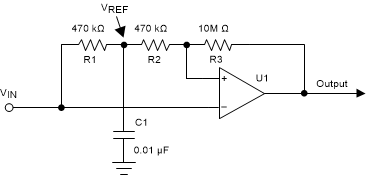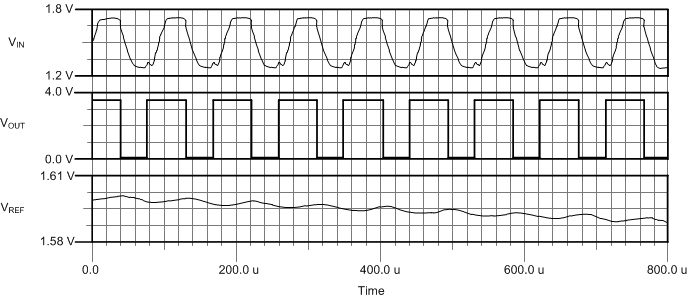SNOSDC8D September 2022 – December 2024 TLV1811 , TLV1812 , TLV1814 , TLV1821 , TLV1822 , TLV1824
PRODMIX
- 1
- 1 Features
- 2 Applications
- 3 Description
- 4 Pin Configuration and Functions
- 5 Specifications
- 6 Typical Characteristics
- 7 Detailed Description
-
8 Application and Implementation
- 8.1 Application Information
- 8.2 Typical Applications
- 8.3 Power Supply Recommendations
- 8.4 Layout
- 9 Device and Documentation Support
- 10Revision History
- 11Mechanical, Packaging, and Orderable Information
8.2.9 Pulse Slicer
A Pulse Slicer is a variation of the Zero Crossing Detector and is used to detect the zero crossings on an input signal with a varying baseline level. This circuit works best with symmetrical waveforms. The RC network of R1 and C1 establishes an mean reference voltage VREF, which tracks the mean amplitude of the VIN signal. The non-inverting input is directly connected to VREF through R2. R2 and R3 are used to produce hysteresis to keep transitions free of spurious toggles. The time constant is a tradeoff between long-term symmetry and response time to changes in amplitude.
If the waveform is data, the data can be encoded in the recommended NRZ (Non-Return to Zero) format to maintain proper average baseline. Asymmetrical inputs can suffer from timing distortions caused by the changing VREF average voltage.
 Figure 8-18 Pulse Slicer
Figure 8-18 Pulse SlicerFor this design, follow these design requirements:
- The RC constant value (R2 and C1) must support the targeted data rate to maintain a valid tripping threshold.
- The hysteresis introduced with R2 and R43 helps to avoid spurious output toggles.
The TLV182x can also be used, but with the addition of a pull-up resistor on the output (not shown for clarity).
Figure 8-19 shows the results of a 9600 baud data signal riding on a varying baseline.
 Figure 8-19 Pulse Slicer Waveforms
Figure 8-19 Pulse Slicer Waveforms